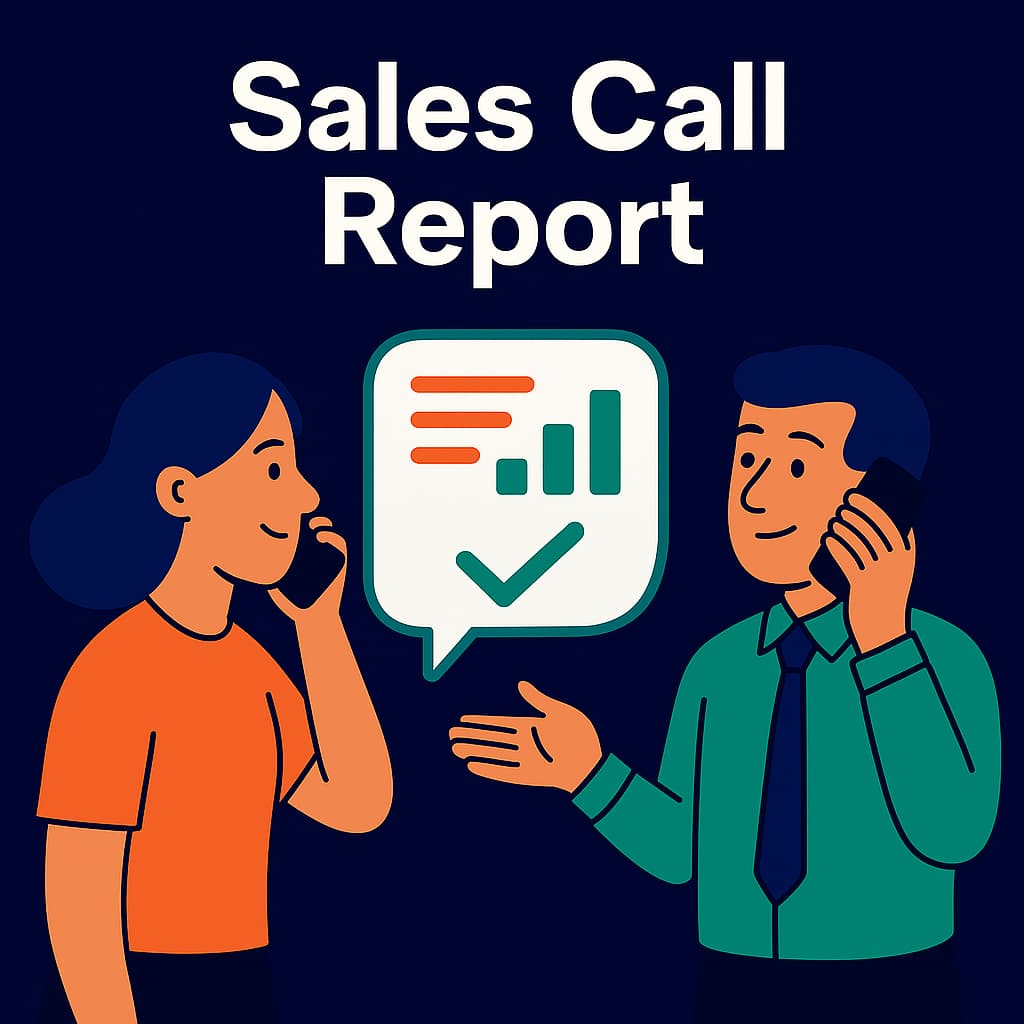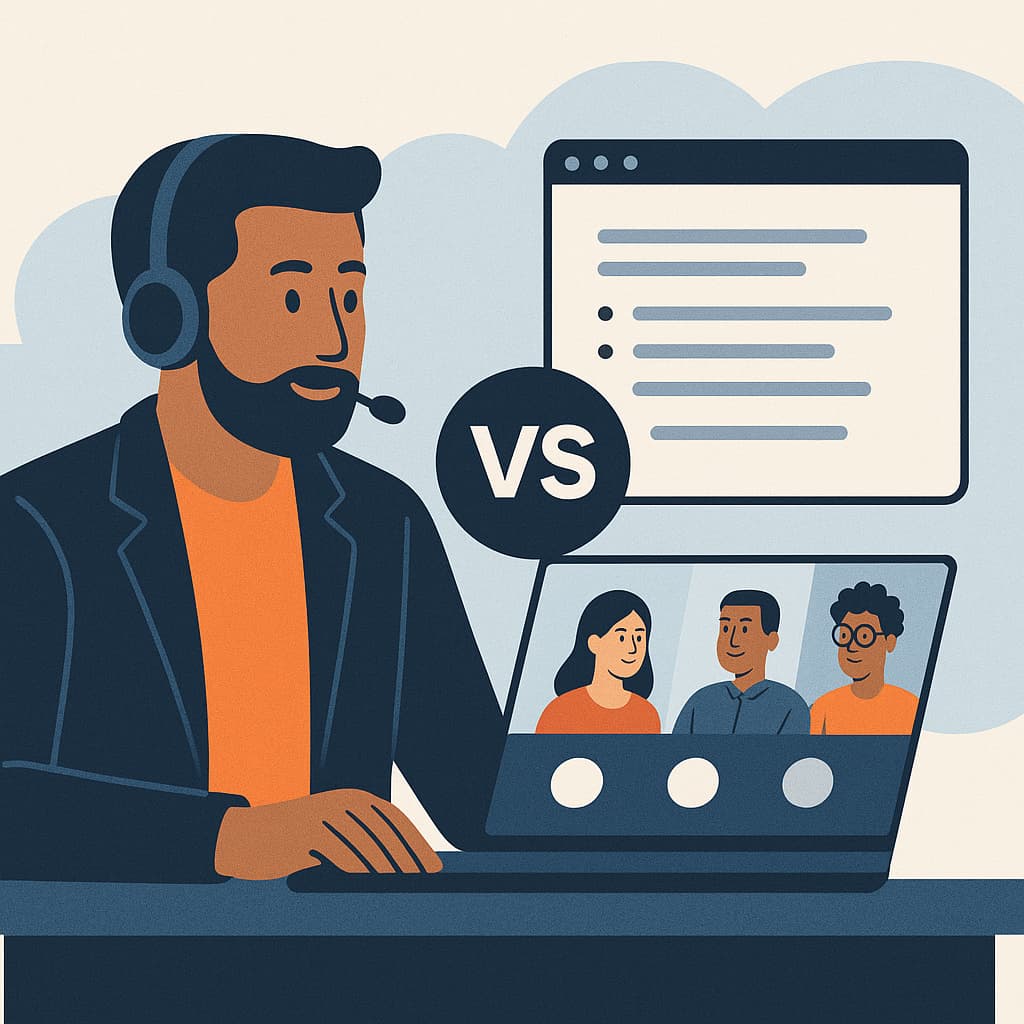Your sales team closed $2M last quarter. Great. But now you're flying blind.
You don’t really know which deals will close this quarter. Some are stuck at 80% probability for weeks. Others close unexpectedly—or worse, disappear without a trace.
It’s not a forecasting problem. It’s a visibility problem.
In this 2026 guide to the best revenue intelligence platforms, we break down what actually works, what’s just hype, and how to pick the right tool for your sales stack.
From conversation insights to forecasting accuracy, these AI-powered tools are changing the game.
Whether you're scaling a startup or running an enterprise GTM team, this list will help you choose the right platform to boost visibility, pipeline health, and sales performance.
The 8 Best Revenue Intelligence Platforms Compared
Here’s the top 8 that stand out: Claap, Gong, Clari, Modjo, Tl;dv, Grain, Aviso, and Salesforce Revenue Intelligence.
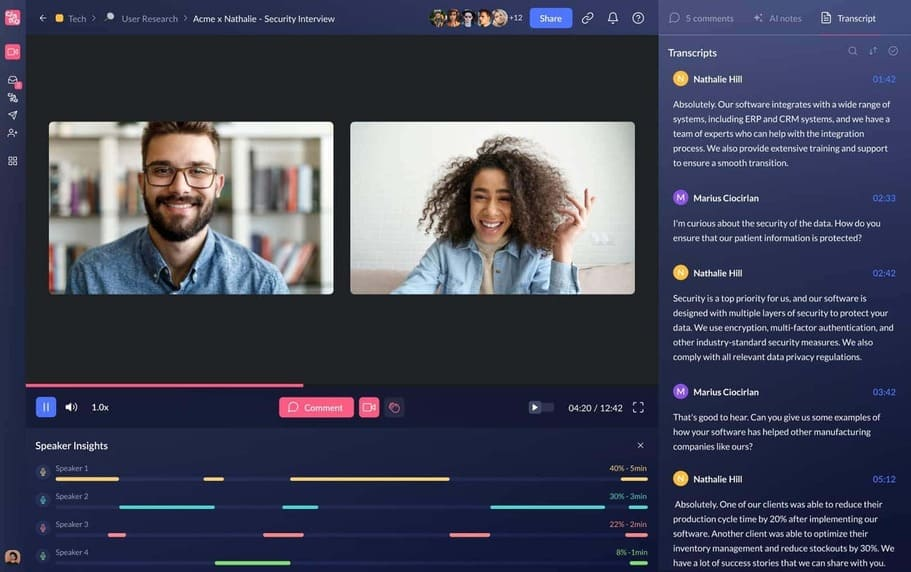
Before diving into the rankings, here’s how the category breaks down:
- Revenue Intelligence tools give you real-time pipeline visibility and predictive insights.
- Conversation Intelligence platforms analyze sales calls to extract actionable data.
- Forecasting & Analytics tools deliver performance metrics, forecasts, and risk assessments.
Each of those 8 best revenue intelligence platforms solves a different challenge—from AI-powered call insights to pipeline forecasting. We’ve grouped them by core strength and reviewed their pricing, capabilities, user feedback, and real-world use cases to help you choose the right fit.
Without reliable pipeline visibility and structured insights, teams can’t predict outcomes or scale performance. Traditional CRMs weren’t built for this—that’s where revenue intelligence software comes in.
Let’s break down the top tools by product strength, user experience, and fit.
Best Overall Revenue Intelligence Platforms for 2026
Claap - Converts conversations into insights and actionable data that fuel intelligent, agent-led sales workflows.
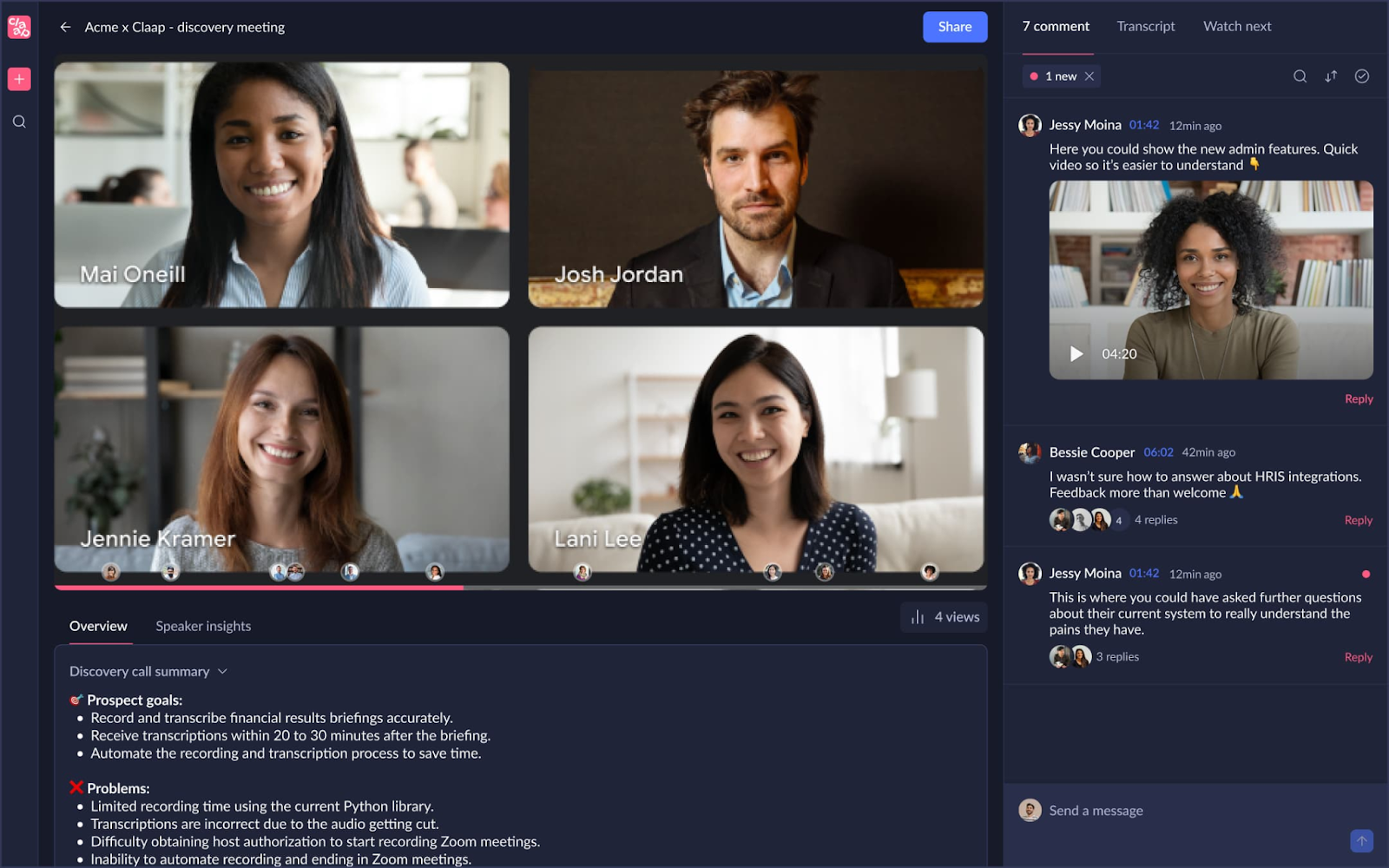
At a glance:
- Best for fast-moving sales teams seeking advanced deal and pipeline insights, auto-filled CRM fields, and frictionless rep adoption.
- This platform excels at delivering real-time conversation intelligence, coaching, and pipeline analytics.
- It provides revenue data that powers AI sales agents and agentic workflows for advanced sales use cases.
Core capabilities:
- Always-on AI copilots that join every sales call
- Automatically tags sales call insights by topic, such as pricing, budget, pain points, or urgency
- Instantly maps data to CRM fields to save time and prevent blank entries
- Acts as your AI teammate, delivering real-time revenue insights and coaching advice
- Provides call intelligence that drives consistent messaging, tailored relationships, and improves win rates
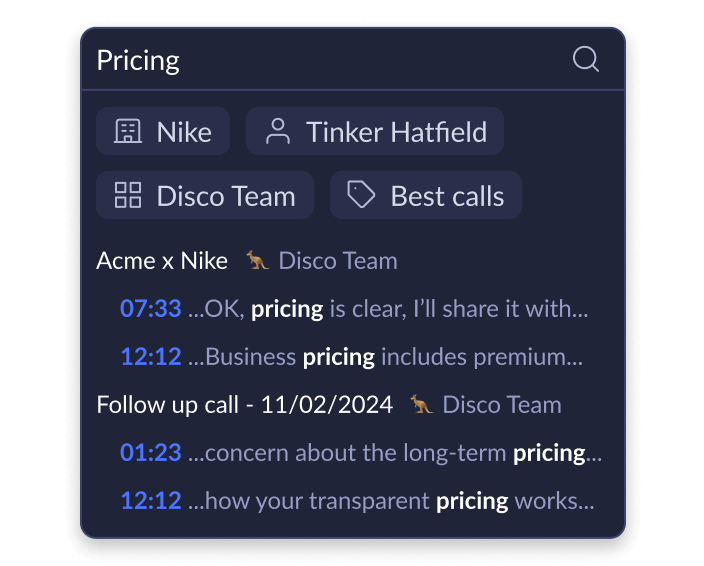
Pros & cons:
- Lightweight and easy to adopt
- Fast deployment and instant CRM sync (Salesforce, HubSpot, Pipedrive, Attio or other via API)
- Delivers structured, real-time deal insights that boost sales productivity and rep confidence
- Built-in sales coaching tools
- Currently strongest for startups, SMBs and mid-market teams
- Requires a structured process for full impact
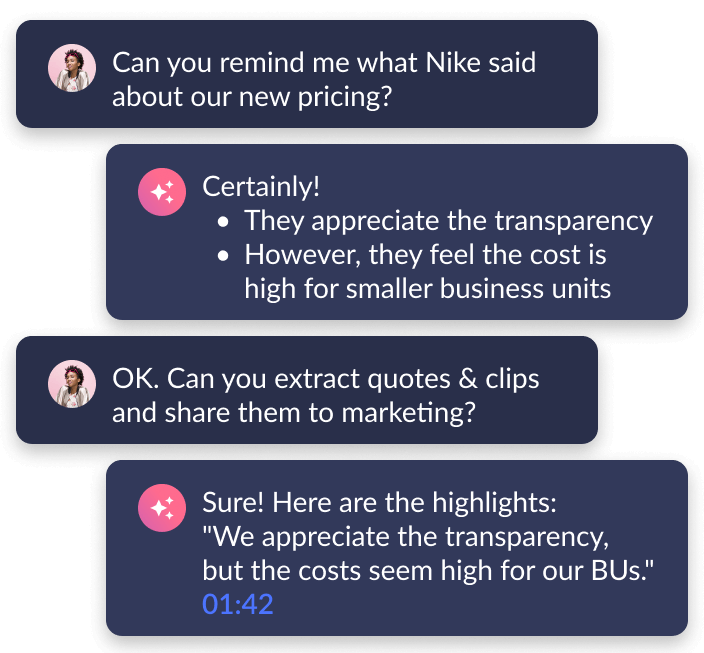
Real user feedback:
"Claap helped us get insight into how the calls are going. Do we understand what the customer wants, or are we just talking all the time?"
— Sjors de Kleijn, Head of Revenue Operations @TenderApp
“We’ve increased the share of value captured from 26% to 35% of our target deals. That’s a big jump — and Claap gave us the visibility to know what was working.”
— Claire Heskin, Chief Marketing Officer @Ronspot
Pricing:
Starts at $25/month per user. Free plan available to test the software. Enterprise pricing available on request for large sales organizations.
Gong - A platform that excels in deep conversation analysis and deal risk visibility for enterprise sales teams
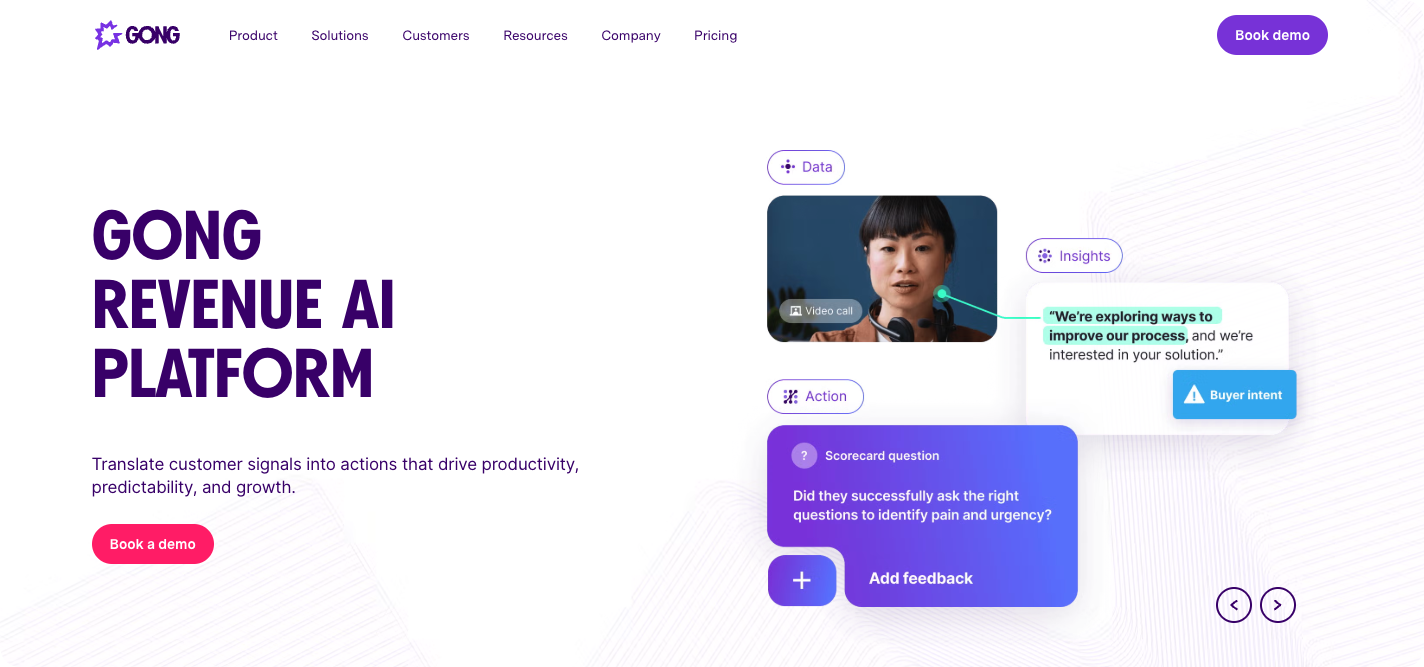
At a glance:
- Best for: Large orgs that want layered visibility and in-depth call analysis
Core capabilities:
- Conversation transcription, keyword tracking, and topic flagging
- Deal warnings based on rep behavior and buyer engagement
- Multi-threaded buyer mapping
- Integration with all standard sales stack tools
Pros & cons:
- Extremely detailed analytics
- Trusted by enterprise sales teams
- High cost of entry
- Challenging for admins to learn and not very intuitive for reps, limiting adoption.
Real user feedback:
“Gong tells me where the deal is headed — before the rep does.”
“Without Gong, we wouldn’t know how our top reps run their calls.”
Pricing:
- Base Pricing: Approximately $1,200–$1,600 per user per year, depending on team size and contract terms, based on industry reports.
- Platform Fee: A mandatory fee of $5,000 per year.
- Additional Costs: Optional onboarding and training services may incur extra fees
Read our complete breakdown of Gong's 3-tier pricing structure here.
Clari - Built around predictive forecasting and multi-source pipeline visibility
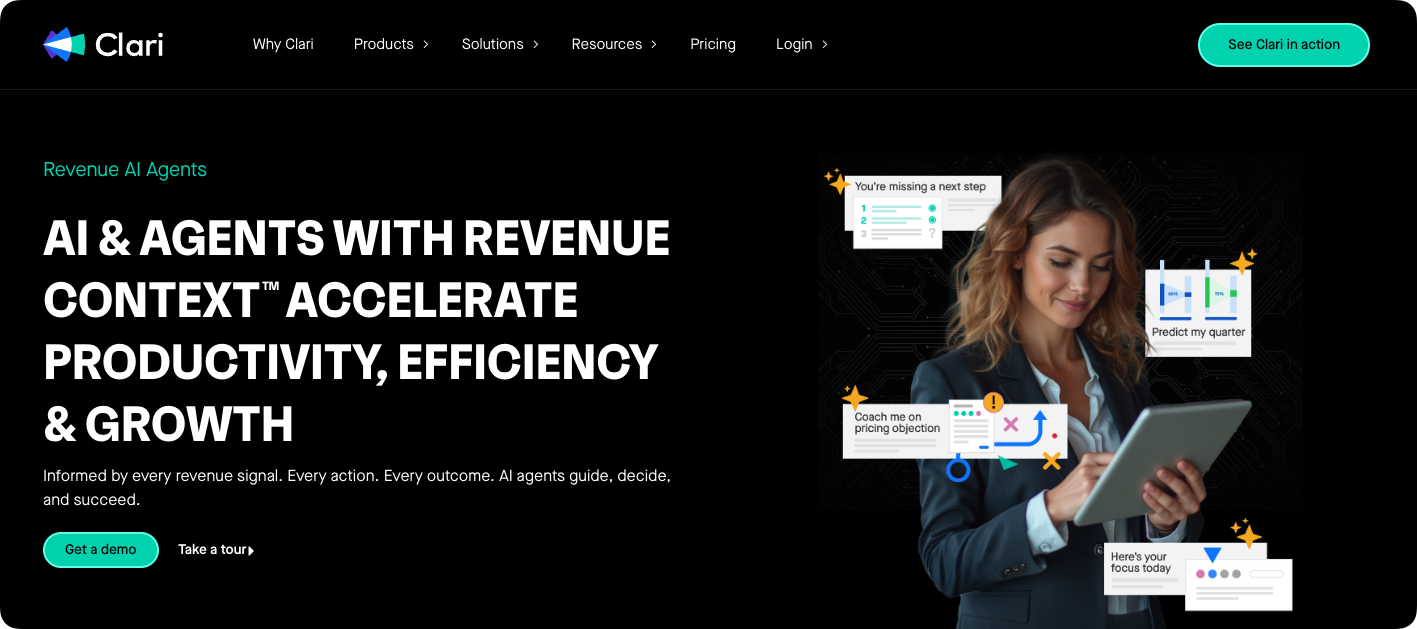
At a glance:
- Best for: RevOps leaders focused on pipeline accuracy and multi-quarter forecasting
Core capabilities:
- AI-powered pipeline inspection
- Real-time forecast modeling
- Deal movement tracking across stages
- Seller activity scoring
Pros & cons:
- Great for forecasting across large teams
- Integrates multiple data sources (email, calendar, CRM)
- Implementation can be lengthy, limiting fast ROI and adoption
- Best suited for organizations with mature RevOps functions
Real user feedback:
“We closed our forecast gap by 20% in one quarter after adopting Clari. It’s the only dashboard our CRO looks at every day.”
“Clari gave us confidence in our numbers. Forecast accuracy went from ‘gut feel’ to grounded reality.”
Pricing:
Custom pricing based on volume and feature access. Clari Copilot: Starts at $1,080 per user per year. For Clari Align and Clari Forecast: Pricing available upon request.
Best Conversation Intelligence Tools for 2026
Claap - Call intelligence built-in, deal insights and live coaching to help teams close faster
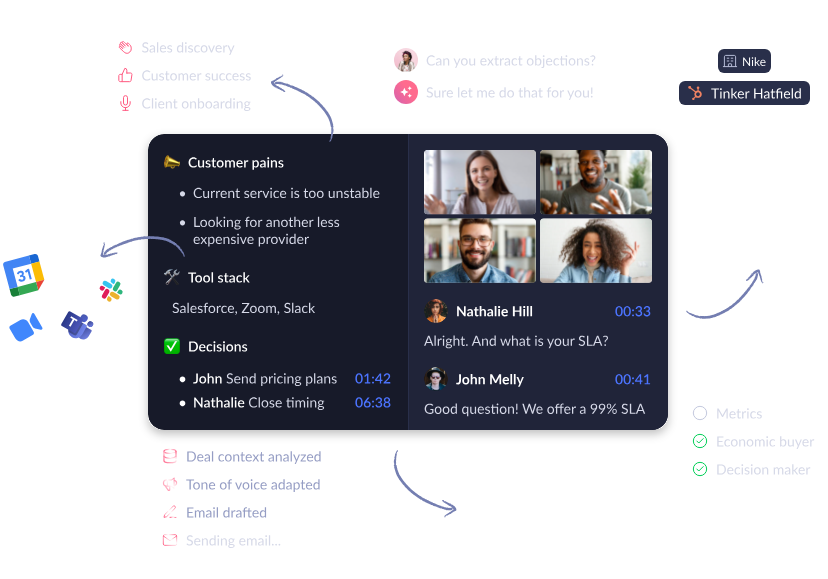
At a glance:
- Best for teams that want conversation insights directly connected to their Sales stack (CRM, Notion, Slack, AI agents, and other revenue tools)
Core capabilities:
- Call recording, transcription, and automatic note taking
- Insights detection (next steps, objections, churn risks, market trends, buyer intent)
- Real-time coaching embedded in the rep’s workflow and synthesized for managers
- Pushes structured data into Salesforce, HubSpot, and all major revenue tools
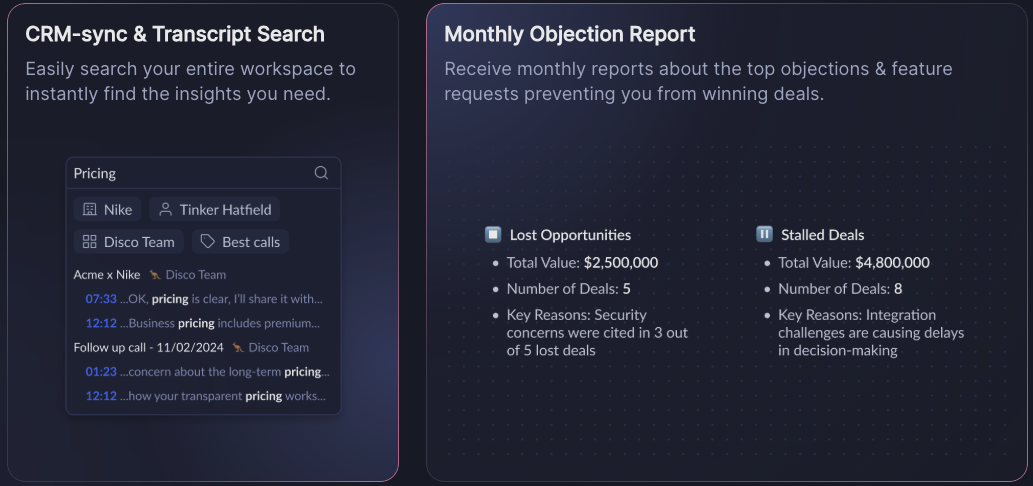
Pros & cons:
- See previous section for a full breakdown of Claap. In Conversation Intelligence specifically, Claap stands out for live coaching, call insight detection, and CRM-ready data tagging for deeper conversation analysis
Real user feedback:
"Claap doesn’t just show you what happened — it makes sure your team knows what to do next."
Pricing:
Starts at $25/user/month. Free to try. Scales with your team (custom pricing available for large sales teams).
Modjo – Powerful insights for sales coaching
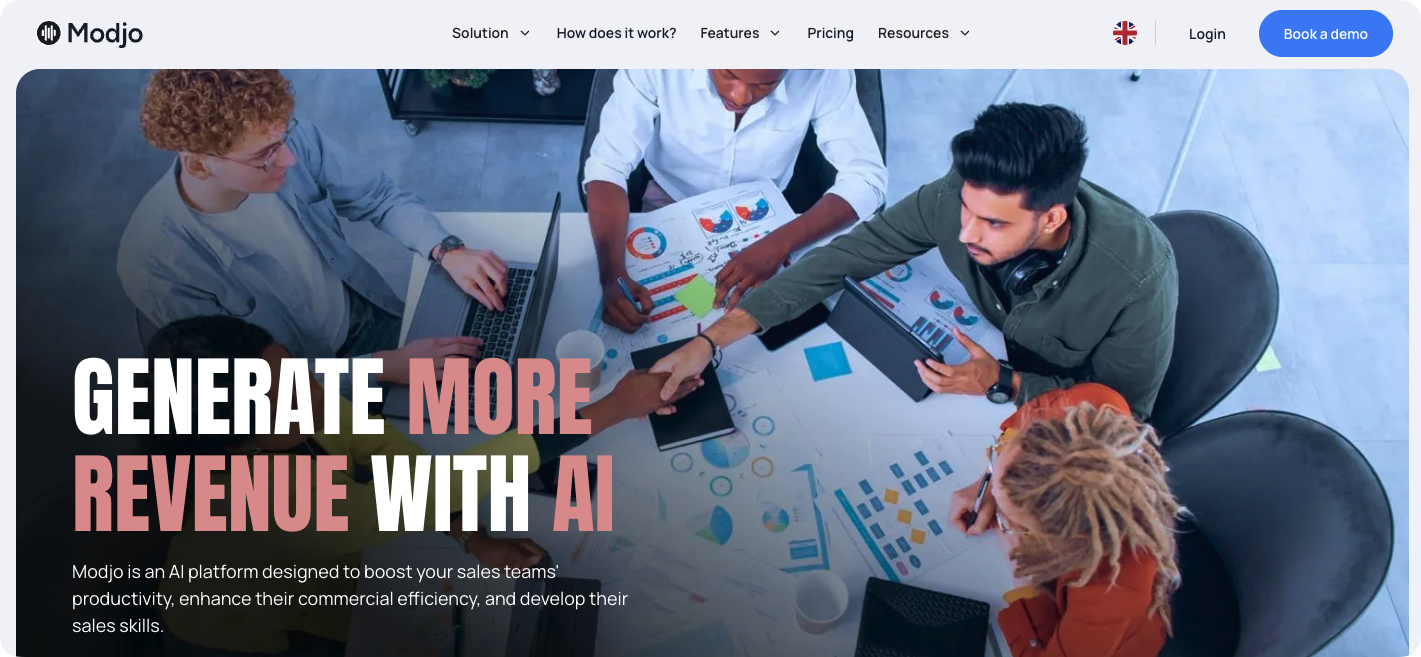
At a glance:
- Best for: Teams focused on onboarding, and performance improvement
Core capabilities:
- High-quality transcription and speaker tracking
- Conversation tagging by topic and objection
- Performance dashboards and coaching heatmaps
Pros & cons:
- Excellent for training use cases
- Dashboards for managers
- Not optimized for forecasting or deal tracking
Real user feedback:
"With Modjo, we cut rep onboarding time in half."
Pricing:
Custom quote required. Sources say ‘Basic’ starts at $100/user/month with full-featured plans & volume discounts available.
tl;dv – Budget-friendly call recording for startups
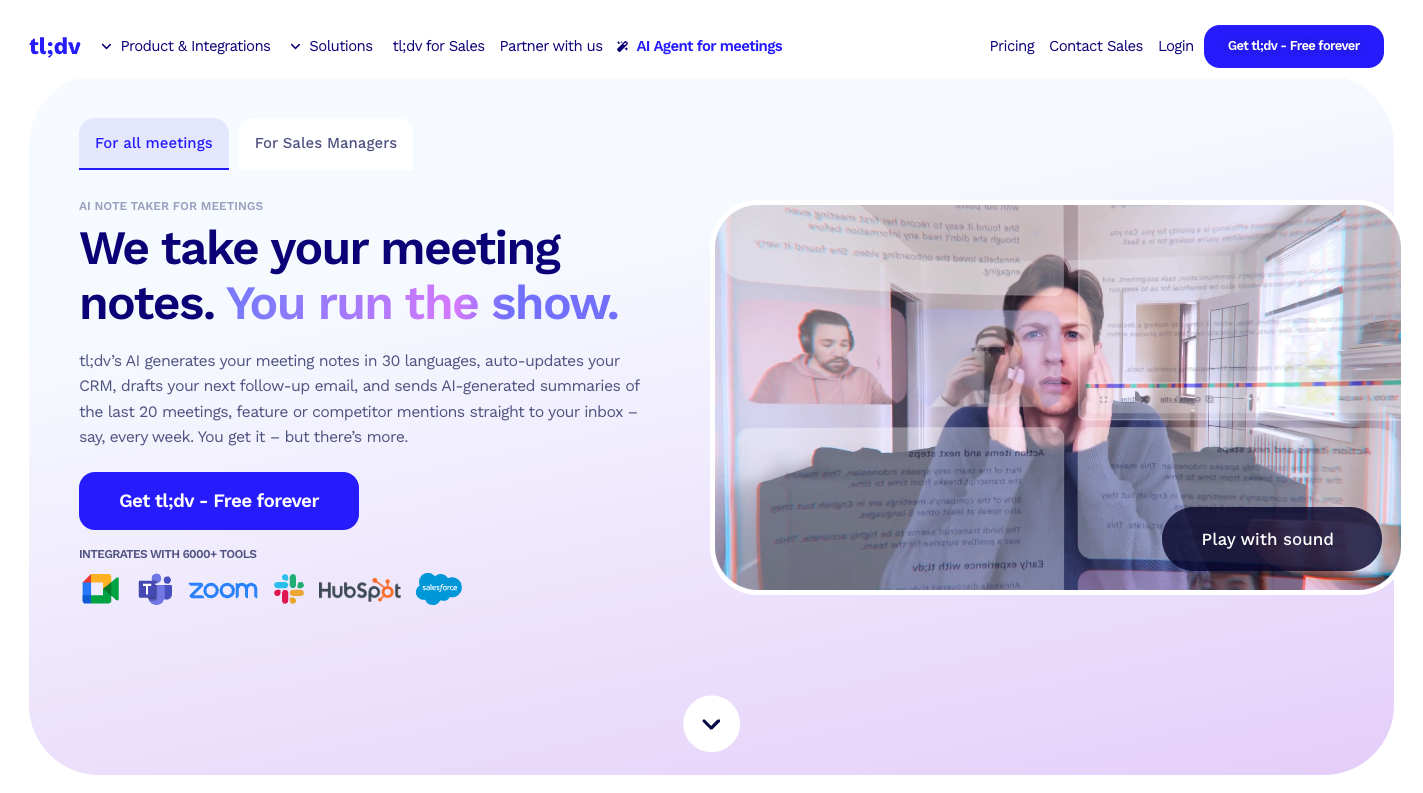
At a glance:
- Best for: Startup teams that want to capture and revisit sales conversations without breaking the bank
Core capabilities:
- Google Meet and Zoom call recording
- Timestamped notes and video highlights
- Easy sharing via links and comments
Pros & cons:
- Searchable transcripts with speaker-level insights
- Lightweight and easy to deploy
- No native CRM integrations
- Limited analytics and sales coaching features
Real user feedback:
"tl;dv is like having a sales archive you can actually use."
Pricing:
From $20/month per user (Pro). Free tier available for limited use.
Grain – Collaborative meeting recorder for remote teams
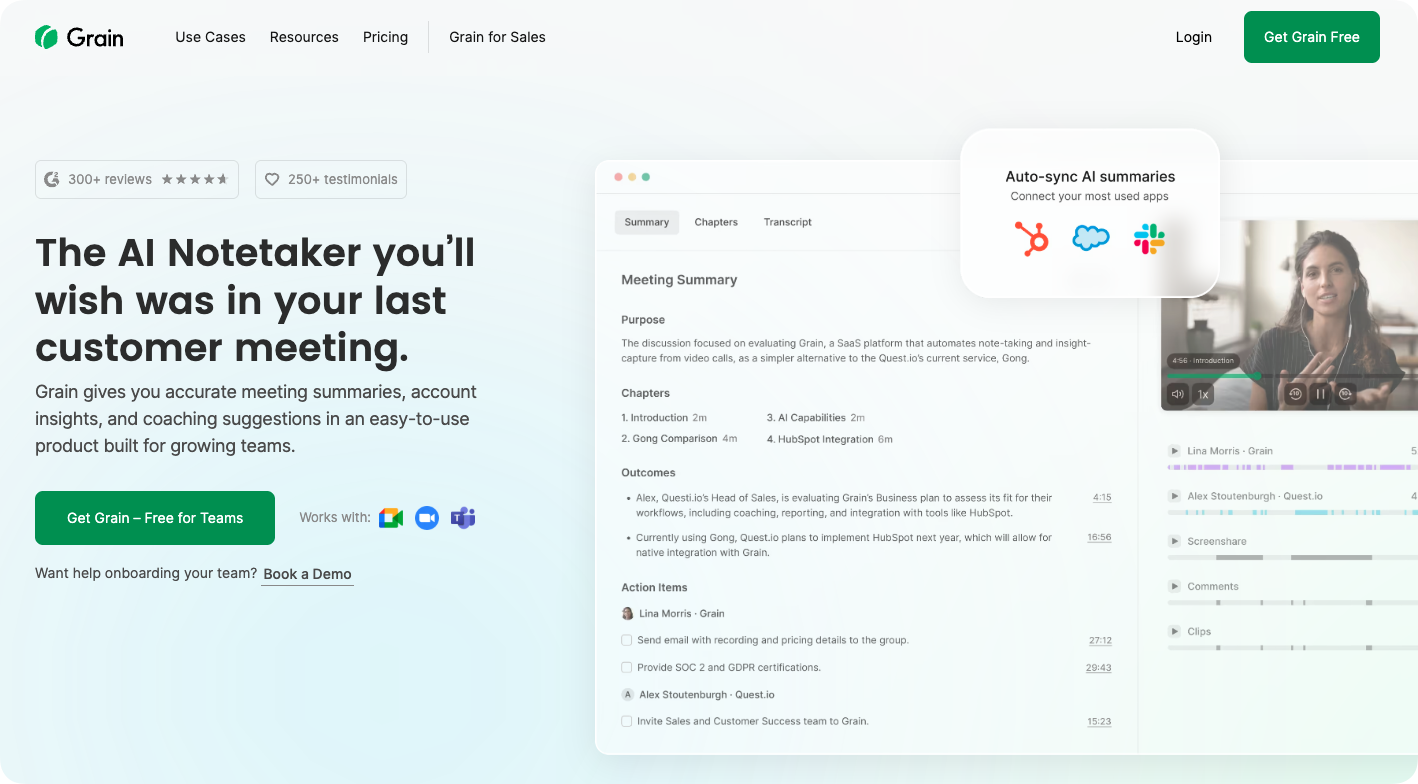
At a glance:
- Best for: Teams that want searchable meeting content and shareable snippets
Core capabilities:
- Real-time transcription and note capture
- AI-generated summaries
- Clip sharing and integrations with tools like Slack and Notion
Pros & cons:
- Affordable and flexible for small teams
- Easy to share insights across the organization
- More of a general meeting tool than a sales-specific platform
Real user feedback:
"Grain helps us make every customer call a reusable asset."
Pricing:
Free for individuals/solo users. Paid plans start at $15 per user per month for Teams
Best Revenue Forecasting & Analytics Tools for 2026
Aviso – Predictive forecasting with deal-level insights
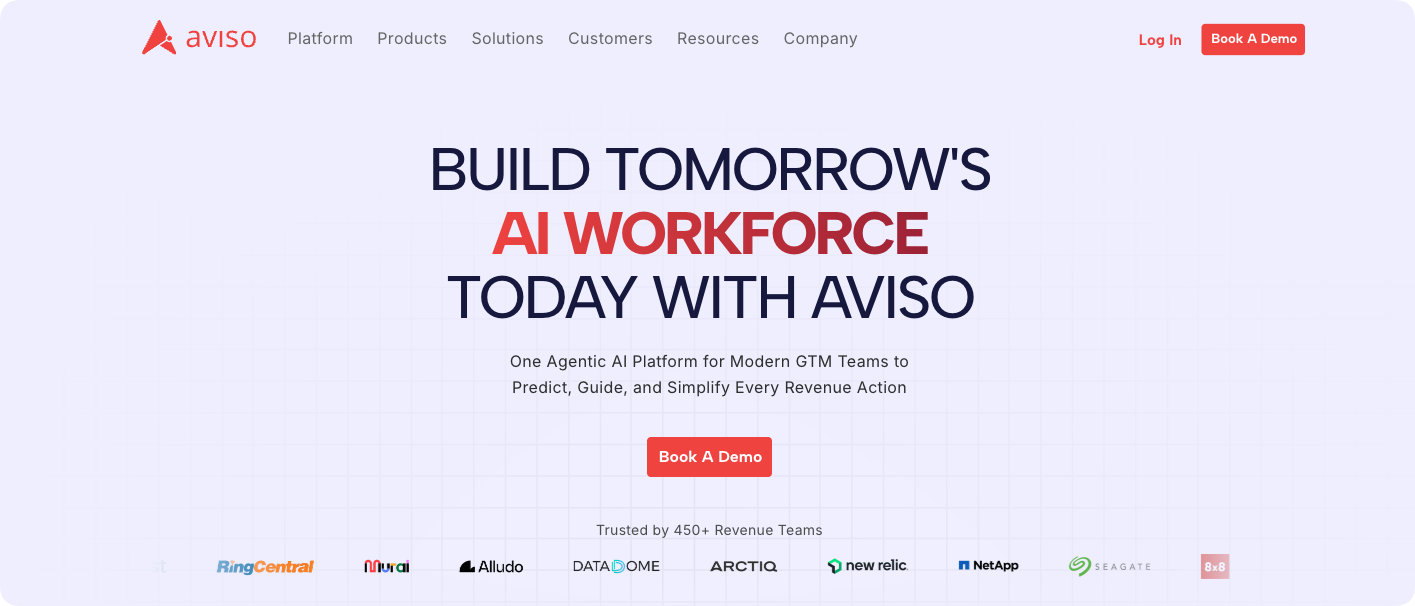
At a glance:
- Best for: Sales leaders and RevOps teams looking for AI-powered forecast accuracy
Core capabilities:
- Predictive forecasting engine trained on historical deal data
- AI insights on deal risk, rep performance, and pipeline health
- Visual pipeline views and forecast scenario planning
Pros & cons:
- Extremely powerful forecasting engine
- Detailed insights at both team and deal level
- Requires data maturity to fully leverage
- Setup and customization can be time-intensive
- According to user reviews, Aviso reduced forecast misses by 20% over 3 quarters
Real user feedback:
"Aviso gave us forecast confidence we never had before."
"The visibility across deals and reps is like turning on the lights."
Pricing:
Aviso is positioned as a premium solution, similar to Clari (around $1,000/user/year), so expect enterprise-level pricing that’s custom quoted after demos and needs assessments
Salesforce Revenue Intelligence – Native forecasting for SFDC users
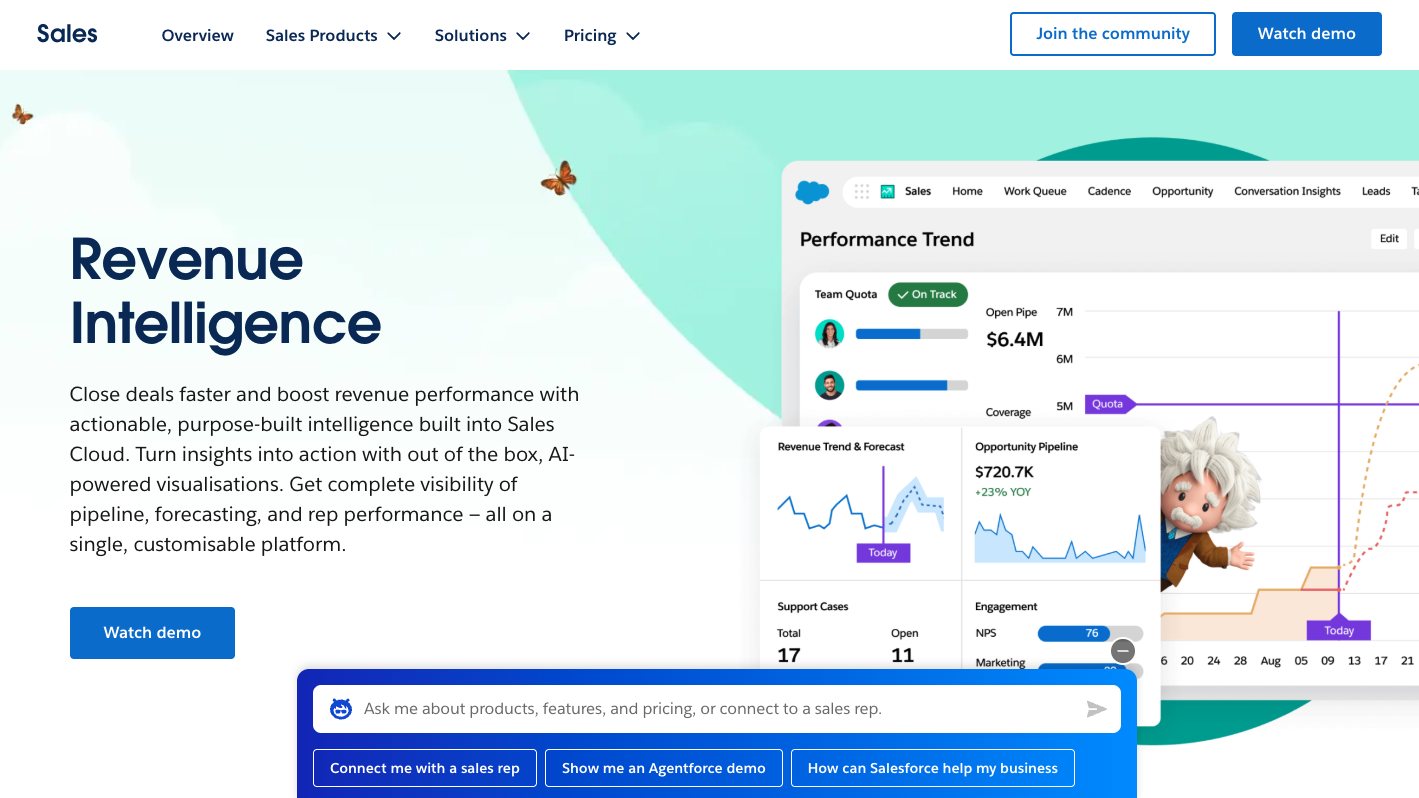
At a glance:
- Best for: Organizations already deep in the Salesforce ecosystem
Core capabilities:
- Opportunity insights powered by Einstein AI
- Deal health and risk scoring
- Custom dashboards and forecast reporting
Pros & cons:
- Salesforce claims up to 15% improvement in forecast accuracy with Einstein AI models — though adoption remains a challenge for complex orgs
- Native integration with SFDC objects, however, is not plug-and-play for non-SFDC users
- Requires Salesforce admin support
- Salesforce isn’t very flexible out-of-the-box and often requires custom coding, which means additional SalesOps resources and costs to implement and maintain
Real user feedback:
"The forecasting is solid, but setup took time. It’s great once configured — but it’s not simple out of the box."
“We finally trust our CRM. Forecasting calls are shorter, and our pipeline reviews are sharper.”
Pricing:
Salesforce Revenue Intelligence is priced starting at $250/user/month when billed annually. These plans require an annual contract, and pricing may vary based on specific requirements and eligibility. For precise pricing tailored to your organization, it's recommended to contact Salesforce directly for a custom quote
Why Sales Leaders Can't Predict Their Revenue
Missed targets. Wasted resources. Shaky board meetings. Sales unpredictability is more than a planning issue — it’s a credibility killer.
Without reliable revenue intelligence software, sales leaders are forced to rely on gut instinct.
The Hidden Cost of Revenue Unpredictability
A recent Forrester Wave™ Report on Revenue Enablement Platforms (2024) found that only 27% of B2B sales leaders say they can accurately forecast revenue beyond the current quarter. This affects not just growth plans but hiring, resource allocation, and investor confidence.
Inaccurate forecasts lead to poor budget decisions, underutilized reps, and marketing efforts that miss the mark. Sales teams are often forced to scramble late in the quarter, chasing deals they should have anticipated slipping.
What Revenue Intelligence Actually Solves
Revenue intelligence replaces guesswork with data-backed clarity. Instead of relying on rep-submitted notes and CRM hygiene, it uses AI to monitor actual buyer-seller interactions.
Teams using revenue intelligence tools report 30% fewer slipped deals, thanks to real-time detection of ghosting risks or stakeholder drop-off.
With revenue intelligence, sales leaders get:
- Earlier visibility into pipeline risk
- Clearer understanding of buyer intent
- Reliable inputs to forecasting models
- Evidence-based coaching opportunities
According to Gartner’s Market Guide for Revenue Intelligence Tools (2024), companies using revenue intelligence platforms report up to 25% improvement in forecast accuracy, 10-15% shorter sales cycles, and 20% higher win rates.
How to choose a revenue intelligence platform?
Key Features to Look for in Revenue Intelligence Platforms
A strong revenue intelligence platform combines predictive forecasting with embedded coaching and sales enablement workflows.
Ask yourself: Does this tool improve sales productivity without slowing down your team?
When evaluating options, prioritize scalability, ease of use, and pipeline accuracy.
Here are five essential capabilities to look for:
- Conversation intelligence: Call recording, transcription, meeting summaries, and highlights.
- AI-powered sales forecasting: Predict revenue with greater accuracy
- CRM integration: Automatically sync insights to Salesforce, HubSpot, or other CRM tools.
- Pipeline visibility: Track buyer signals and deal progression in real-time
- Sales coaching software: Surface rep behaviors that improve win rates
Implementation and cost considerations
Beyond features, consider the total cost of ownership and organizational impact:
- Integration complexity: How well does the platform work with your existing CRM, calendar, email, and sales stack?
- Training and onboarding: How long does it take to get reps and managers up to speed?
- Change management: Will reps need to change daily workflows, or does the platform operate seamlessly in the background?
- Compliance and governance: Does the platform support GDPR, SOC 2, or HIPAA where required?
Cheaper tools often require additional admin or analytics headcount to extract value. Others—like Claap—minimize configuration while delivering structured insights and adoption-ready workflows..
AI That Understands Your Sales Context
When evaluating conversation intelligence platforms, it’s not enough to ask whether they use AI — the real question is how context-aware that AI is.
Look for platforms that support persistent memory protocols like Model Context Protocol (MCP) or an equivalent system. This enables the platform to retain and apply critical information — your sales methodology, buyer personas, deal stages, and playbooks — across every interaction.
The result? Sharper summaries, smarter insights, and coaching that truly fits how your team sells.
But here’s the real differentiator: Claap doesn’t just consume context — it serves it. Thanks to its MCP-based architecture, Claap acts as a context engine for your entire revenue stack. It feeds structured, AI-enriched insights (like MEDDIC scores, objections raised, or buying signals) into your CRM, enablement platform, or forecasting system, enabling intelligent agentic workflows.
💡 Pro tip: Ask if the platform can both use and expose persistent context. That’s what turns conversation intelligence from a standalone tool into a strategic data layer for your entire GTM team.
Your 90-day plan to implement a revenue intelligence platform
Days 1–30: Data audit and integration setup
- Map out all existing tools and CRM workflows
- Choose your revenue intelligence platform
- Connect data sources (calls, calendar, CRM, email)
- Clean or import historical data to ensure a reliable baseline
Days 31–60: Team training and process alignment
- Onboard reps and managers
- Set expectations on usage and outputs
- Enable CRM sync and create alerts/workflows
- Run weekly syncs to review adoption and refine tagging structure
Days 61–90: Optimization and full deployment
- Review insights surfaced to date
- Adjust coaching strategy based on usage patterns
- Expand to cross-functional stakeholders (marketing, product, CS)
- Lock in forecast cadence and KPI reporting
The 3 Most Common Implementation Pitfalls
- Data quality issues that derail projects
Garbage in, garbage out. If your conversation data is incomplete, insights will be too. Clean and audit before rollout. - Change management mistakes that hurt adoption
Rolling out too fast without context leads to low adoption. Educate reps on value — not just features. - Integration challenges and how to solve them
Custom CRM setups can hinder your productivity. Choose a platform that works out of the box or offers strong support for field mapping and syncs.
What ROI should revenue intelligence deliver?
With the right revenue intelligence software in place, companies report up to 25% better forecast accuracy and 30% faster deal cycles. Revenue intelligence is more than a reporting upgrade — it’s a lever for scalable sales productivity.
While results vary by company size and use case, high-performing teams using revenue intelligence software report significant gains in sales productivity and forecasting accuracy. Some expected performance improvements include:
- Sales cycle reduction: 10–20% faster thanks to improved deal visibility
- Win rate increase: 5–15% more deals closed by aligning better with buyer signals
- Rep productivity: 20–30% more efficient through automation and coaching
- Forecast accuracy: 15–25% improvement through real-time insights
Case studies and user reports from platforms such as Gong, Claap, and Clari support these outcomes. For example, Claap reports 2x faster onboarding for new reps, and Gong reports 17% faster deal velocity on average for teams using deal risk surfacing. It’s clear the gains aren’t just theoretical — they show up in the numbers.
Cost vs. return: what to consider
To understand ROI, you need to factor in:
- Cost of licenses, setup, and internal enablement
- Time to full adoption across teams
- Headcount savings from automation (manual CRM entry, note-taking, follow-ups)
- Revenue uplift from better execution and coaching
💡 Pro tip: Many platforms offer ROI calculators or live benchmarks during the sales process. Ask for these to align expectations internally.
Making your final decision
If your team is still relying on CRM dashboards alone, it’s time to upgrade to revenue intelligence software built for scale, speed, and precision.
You’ve seen the platforms. You’ve read the use cases. Now it’s time to decide.
Here’s a recap checklist designed to help you make the right decision:
✅ Does the platform integrate with your existing workflows and CRM softwares?
✅ Will your team actually use it daily, without friction?
✅ Is the vendor UI and support strong enough to ensure a clean rollout?
✅ Can you tie usage to real business outcomes within 90 days?
✅ Are costs transparent and predictable?
FAQ: Revenue Intelligence Platforms
What’s the difference between revenue intelligence and CRM analytics?
Revenue intelligence uses AI to analyze real conversations and activities across the pipeline, delivering live context and actionable insights. CRM analytics typically report on static, rep-entered data — which can be incomplete or outdated.
How much should I expect to spend on revenue intelligence software?
Entry-level tools like Claap, tl;dv, or Grain start around $25–$50/user/month, while enterprise platforms like Gong or Clari can cost $1,200–$2,000/user/year. Final pricing depends on features, integrations, and support levels.
Which platforms work best with Salesforce?
Claap, Modjo and Gong integrate seamlessly with Salesforce — no need to rip and replace. They push structured insights like objection types, deal stages, and next steps directly into your CRM, eliminating manual entry.
How long does implementation typically take?
Lightweight tools can be up and running within hours. Enterprise platforms often require several weeks for configuration, training, and change management.
What data sources do I need to make this work?
Revenue intelligence relies on access to calls, meetings, emails, and CRM data. The more complete and contextual your data, the more accurate the insights.
Can small businesses benefit from revenue intelligence?
Absolutely. Modern platforms like Claap are designed for fast-moving teams, improving coaching, visibility, and execution without heavy onboarding.
How do I measure ROI from revenue intelligence?
Track improvements in forecast accuracy, win rates, sales cycle length, and rep productivity. Also factor in time saved from manual updates and improved pipeline health.
What happens to my data if I switch providers?
Choose a platform that allows full export of structured updates and conversation data. Claap supports full data portability to avoid vendor lock-in.
How do these platforms handle compliance (GDPR, SOC2)?
Look for vendors offering region-based hosting, redaction tools, role-based access control, and documented compliance certifications.
What’s the biggest mistake companies make when implementing revenue intelligence?
Expecting the platform alone to solve everything. Successful teams invest in rep enablement, CRM hygiene, and usage accountability alongside the technology.

![8 Best Revenue Intelligence Platforms with Reviews [2026]](https://cdn.prod.website-files.com/6262a9705cabe0833039d5c8/6945dc7a90807c6971b69d3a_Revenue-intelligence-platforms.jpg)

